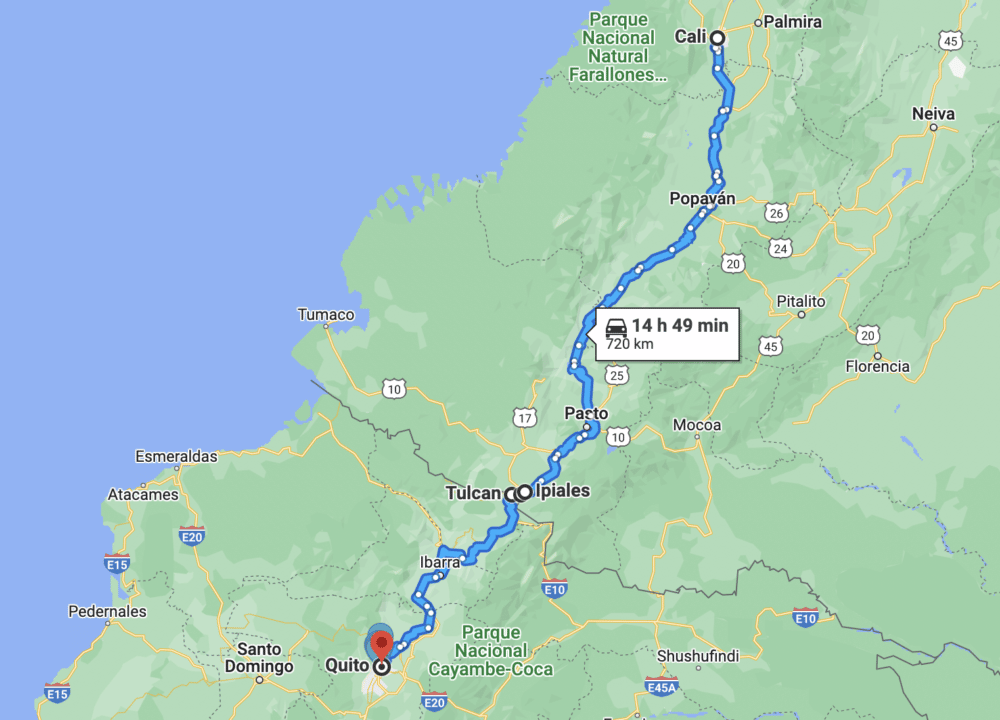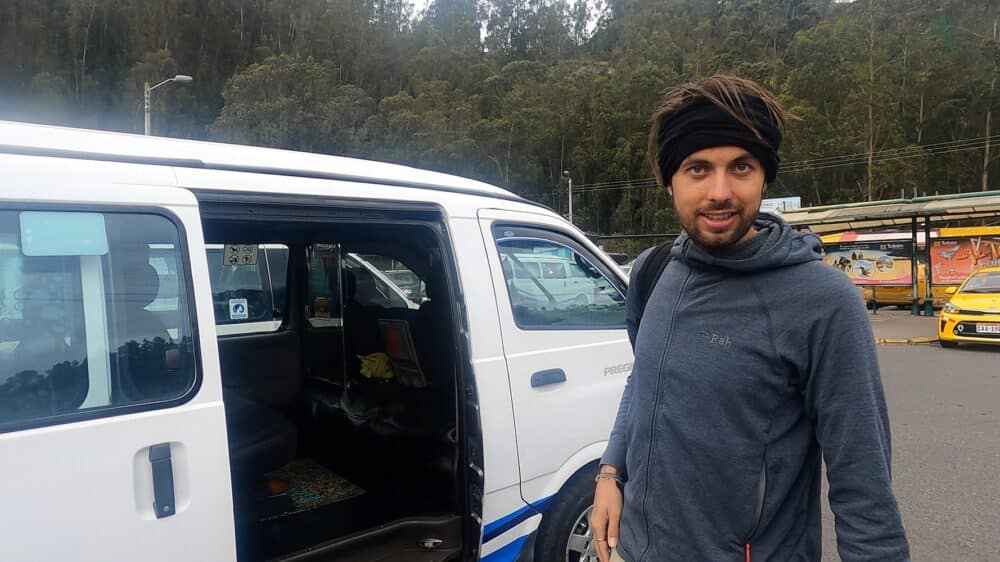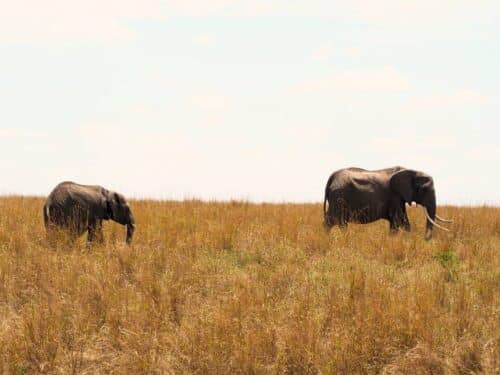Are you finishing your trip around Colombia, thinking about going to Ecuador by bus? Make sure to read our guide, where we’ll show you how to cross the border from Colombia to Ecuador by public transport. It’s easy, cheap, safe, and fairly quick.
Are you looking for specific information? Go ahead:
ToggleCrossing the Land Border from Colombia to Ecuador
Here it comes! Another border crossing, this time from Colombia to Ecuador. Not that we wouldn’t still have so much to say about Colombia (and some countries before and after, to be honest), but I decided to share this article first in order to keep the information as up-to-date as possible.
We used Rumichaca International Bridge as a crossing point (the one most travelers use) and the whole trip took us just over 20 hours (or about 22 door-to-door). The total costs from Cali to Quito were €21 per person.
To compare, the typical price of a flight ticket from Cali to Quito is currently €146 only with a carryon and the flight takes at least 4 hours (with a layover in Bogotá, a direct flight from Bogotá could be about €90 with a carryon, and would take 2 hours + whatever you need at the airport). When traveling by land, you’re not only saving our planet but also your money.
Travel Itinerary: From Colombia to Ecuador via Rumichaca Bridge
The whole journey with a budget per person:
- Day 1 / 8:00 pm Cali → Ipiales 6:00 am; Basic bus 65.000 COP ≈ €13
- Day 2 / 6:30 am Ipiales → Rumichaca 6:40 am; Colectivo 2.500 COP ≈ €0.50
- Day 2 / 7:40 am Exiting Colombia
- Day 2 / 8:20 am Entering Ecuador
- Day 2 / 8:30 am Rumichaca → Tulcan Bus Terminal 8:45 am; Colectivo $0.75
- Day 2 / 10:00 am Tulcan → Quito 4:15 pm; Basic bus $7.25
Total cost: €21
You’ll find a detailed description of the journey with all the directions and important information in the following paragraphs.
DIY Journey from Cali to Quito by Public Transport
*5.000 COP ≈ $1 ≈ €1
We made this trip in April 2022 and we actually went all the way from Cali to Quito by bus in one go. You can also make another stop along the road and split the trip. Las Lajas Sanctuary is a popular place to visit on the Colombian side and Otovalo town with its huge market on the Ecuadorian.

Cali to Ipiales by Bus | Day 1
There are buses going from Cali to Ipiales every hour or two from the bus terminal. You can check the availability and times on redbus, but we were never able to buy the ticket with our Revolut card. It’s not a problem. You just need to go to any bus terminal and buy the ticket at the counter of the company.
We chose an overnight bus at 8 pm from the company Expreso Bolivariano. Unfortunately, there was no double-decker, but you might want to check if you have more luck. The first floor is usually first class, which means bigger and more comfortable seats declining by 160°.
The bus was supposed to get us to Ipiales at 8 am, but it arrived 2 hours earlier. When we got out, it was madness. Everybody was trying to sell us something, offering a ride to the border and whatever else. We wanted to take our time, use the bathroom, etc., so we went to the terminal.
Colectivo from Ipiales to Rumichaca Border | Day 2
Good to know: the bathrooms at the bus terminal in Ipiales are open in the morning. While I was waiting at the terminal, a security guy approached me and told me to only use the official services – a yellow taxi or white colectivo. There are also other people offering the ride, as I mentioned, and with those, apparently, incidents tend to happen.
We listened to the advice and took the official white colectivo. You’ll find the station just behind the terminal building – you can always ask the security guy or the orange taxi drivers. It was 2.500 COP (€0.50) per person, a taxi would be 8.000 COP (€1.60).

Crossing the Border from Colombia to Ecuador at Rumichaca Bridge
We got to Rumichaca at 6:40 am and it took us almost two hours before we entered Ecuador. There was almost no line at the Colombian immigration office this early in the morning. When we wanted to enter the office to get our passport stamped (don’t forget to do that!), we found out we need to have the Check-Mig form filled out.
Check Mig is a document introduced during the pandemic. You need to fill it out 1–24 hours before entering the country and, obviously, before leaving as well.
You can do that at the official government webpage or in the app, but I encourage you not to leave it to the border. The internet connection is really bad there (and if you don’t have data, you’re screwed), it took us an eternity. After that, the process was swift.
When we got our stamp, we wanted to exchange our leftover pesos. There are many people offering that, but make sure you know how much you’re supposed to get. According to the official rate, we were supposed to get $85 for our pesos. The guy was trying to get it for $41, and we got $75 in the end.
Entering Ecuador by Land
The Ecuadorian immigration office at Rumichaca doesn’t open before 8 am. We were actually happy everything took so long on the Colombian side and we didn’t need to wait much longer. Btw. it’s really cold there since it’s about 2.500 masl. And I had shorts.
Anyhow, when they opened, we had our covid vaccine certificate checked first, and went to the immigration office. It took like two minutes to get the stamp and we were in Ecuador. Just like that.
You’re not supposed to pay anything (as an EU citizen) and don’t forget to check the date and how many days did you get.
Now, you need to get another taxi/colectivo from Rumichaca to Tulcan Bus terminal. The taxi/colectivo station is visible from the immigration office and it’s pretty clear which is official and which is not. The colectivo was $0.75, a taxi would be $3.

From Tulcan to Quito by Bus (or anywhere else)
You can take a bus from the bus terminal in Tulcan anywhere to the northern part of Ecuador. To be honest, calling it terminal is a bit exaggerated. There were buses from Tulcan to Quito every two hours or so. We picked one at 10 am for $7.25.
It seemed like one of the better ones. You can always make them show you for which bus you’re buying a ticket. Don’t forget you’ll sit in it for at least 6 hours if the traffic is good (or about two hours if you’re only going to Otovalo).
We got to Quito at 4:15 pm and took a trolley bus & two buses to our coliving in Floresta. And that was it! We made it home around 5 pm, almost exactly 22 hours after we left our hostel in Cali.
Final tips for the Trip from Colombia to Ecuador
- Always check on both government’s websites what you need to leave/enter the country – for us, as EU citizens in April 2022, it was: Check-Mig to leave Colombia and a vaccination card with two doses to enter Ecuador (and a passport, of course)
- Since the region close to the border is one of the areas in Colombia where violent strikes happen from time to time, check if the situation is ok at the time when you want to go
- You can exchange your leftover pesos for dollars at the border, but make sure to check the exchange rate before
- You can buy a sim card in Tulcan, with a credit for 3 days, and recharge it later (I think it was for $5)
- The buses in Colombia are usually pretty safe, but we’ve heard this route tends to have more robberies – watch out for your valuables!
- The buses in Ecuador are NOT so safe – we didn’t have any problems during our three months there since we were really careful, but we’ve heard one too many stories about people who got their backpacks cut and valuables stolen – always keep it on your lap, it’s never safe under the seat in Ecuador
- There are options to buy coffee and breakfast near the bus terminal in Tulcan
- The public transport in Cali works well and you can easily take a local bus to the bus terminal – we had a rechargeable card, but noticed later that a Visa card might be enough
- The public transport in Quito works, it’s just not so well organized and the buses usually don’t go after it gets dark; one ride is $0.35 and we felt pretty safe
Like it? Pin it!




